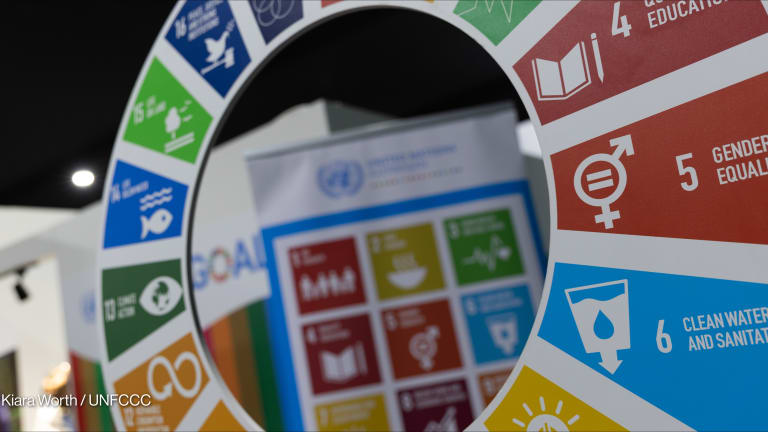
NEW YORK — Sustainable Development Goal 16, aimed at achieving peaceful, inclusive societies and access to justice for all by 2030, remains far off-track for completion by the target date of 2030.
Lack of quality funding is one key issue that prevents more than 5.1 billion people globally from having “meaningful access” to justice. But the problem of injustice is a complex one, Irene Khan, director-general of Rome-based International Development Law Organization, explained to Devex. And it will not likely be solved during Khan’s tenure at the organization, as she will wrap her two-term position later this year.
Devex caught up with Khan on the sidelines of the ongoing U.N. High-level Political Forum on Sustainable Development, to discuss SDG 16, one of the goals under review at this year’s meeting. Khan outlined ongoing challenges and solutions that need to be considered for achieving justice and inclusive societies.
This conversation has been edited for length and clarity.
“There is a real issue here of donors needing to recognize they have to make an investment over a period of time.”
— Irene Khan, director-general, International Development Law OrganizationHow far are countries from reaching SDG 16 right now?
Progress on SDG 16 is not going well. If work is not accelerated, then we will not reach it by 2030, because SDG 16 is a very complex goal.
Climate change, inequality threaten shaky SDG progress, UN reports
The majority of the Sustainable Development Goals — from zero hunger to no poverty — remain off track, the U.N. finds in its latest SDG checkup.
It is about justice and it is difficult to define justice. What we do know is there are a lot of people whose rights are not properly protected, and who are unable to claim remedies for those rights. There are targets and there are indicators, but the challenge is how do you capture the complexity of the issue? There are indicators that have been adopted about measurements of homicide, but reduction of homicide does not necessarily reflect the full picture of injustice.
How have you seen places take this SDG on and adapt it to fit their local environments?
We recognize that the justice needs of people vary. If you take something like business or commercial areas, the needs of men and women are not different. But then you look at issues like domestic violence, you see that women’s need for justice is about 75% more than that of men. There are variations one has to take into account, and then of course also the overall state of the country. A cookie-cutter approach does not work. That has been proven. It is a complex issue, but it is not an insurmountable issue. There are a lot of places where progress is being made.
How do you confront the issue of corruption when approaching justice work?
We have an overall approach that shows that if we are going to work in the area of access to justice, including corruption, then there has to be a top-down and a bottom-up approach. One has to build institutions, but one also has to empower the users.
We have worked with local Ukranian authorities to establish public service centers where people can go to one place and actually access all of their basic needs, such as identity papers. In the past, these systems have been mired in corruption. We simplified the rules, computerized systems, and made the offices physically transparent. Citizens were reacting very positively to that. We also worked with local NGOs and civil society and strengthened their capacity to be watchdogs.
As you think about the end of your tenure at IDLO, what are some of the challenges you think your successor will need to take on?
We know there is an enormous amount of work to be done. If you look at the context of institution building, it takes decades. There is a shortage of funding as a whole, but there is a shortage of quality and flexible funding. There is a real issue here of donors needing to recognize they have to make an investment over a period of time. It is very hard to set up projects, get people on board in developing countries, help them to develop their own capacity to deliver the project, and not to have any certainty whether money will be available next year. The issue of donor funding needs to be reviewed. Otherwise, the results are not achieved.








